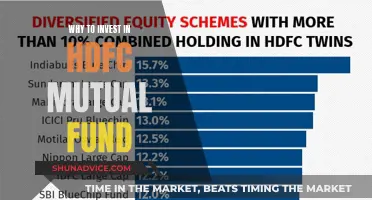
Mutual funds are a popular investment option for people looking to save for the future and earn decent returns on their investments. They are also tax-efficient investment vehicles. One of the most significant benefits of investing in mutual funds is the ability to save on taxes. Mutual funds are typically regarded as one of the most profitable investment options. They offer a convenient and efficient way to invest in a diversified portfolio of stocks, bonds, and other securities, reducing the risk associated with investing in individual stocks or bonds.
Mutual funds are managed by professional fund managers who make investment decisions and manage the fund’s portfolio on behalf of its investors. By investing in mutual funds, investors can take advantage of the tax benefits that come with investing in different types of funds, such as equity mutual funds, debt mutual funds, and hybrid mutual funds.
Tax-saving mutual funds, also known as Equity-Linked Savings Schemes (ELSS), offer tax benefits to investors under Section 80C of the Income Tax Act. ELSS funds are the only tax-saving funds within the Rs 1.5 lakh limit that have the additional advantage of giving equity-linked returns. Investing in ELSS allows investors to get dual benefits – they get capital appreciation and tax benefits.
- Tax Exemption: Up to ₹1,50,000 per annum can be claimed as tax deductions under Section 80C of the Income Tax Act.
- Lock-in Period: ELSS funds have a minimum lock-in period of three years, which means investors cannot redeem their investment during this time.
- Risk: ELSS funds invest primarily in equities, which are considered riskier than other types of investments. Returns are not guaranteed and can fluctuate based on market conditions.
- Investment Amount: The minimum lump sum investment amount is usually ₹500, and investors can also opt for a Systematic Investment Plan (SIP) with a minimum investment as low as ₹500 per month.
- Returns: Historically, ELSS funds have generated higher returns compared to traditional fixed-income investments, providing better inflation-adjusted returns over the long term.
What You'll Learn

Dividend Distribution Tax (DDT)
In India, the DDT rate has varied between 10% and 20%, plus applicable surcharge and cess. The mutual fund deducts the DDT from the dividend payment and deposits it with the government. This reduces the amount of dividend income received by the investor.
The abolition of DDT in 2020:
- In the 2020 budget, the Finance Minister of India proposed to abolish DDT, which was well-received by domestic companies.
- As a result, the tax on dividends is now calculated based on the shareholder's income tax slab rate.
- Dividend income is now considered "income from other sources" and investors must pay tax on it according to their individual tax slabs.
- This change has made it a level playing field for both growth and dividend options under a mutual fund scheme.
Impact on investors:
- Investors in a higher tax slab will end up paying more tax on dividends than those in a lower tax bracket.
- DDT had a uniform impact on all investors, reducing the distributable surplus of the scheme by applying a uniform tax rate.
- With the removal of DDT, investors can now weigh the benefits of opting for a dividend option, considering the effective tax rate (including cess and surcharge) and their need for dividend income.
Other key points about DDT:
- DDT was payable separately from the income tax liability of a company. No deductions or credits were allowed for DDT payments.
- DDT was not payable if the dividend was paid on behalf of the New Pension System Trust.
- If an Indian company received dividends from a foreign subsidiary, this dividend was taxed at a concessional DDT rate of 15%.
- There were no provisions for deductions due to loss, expenditure, or allowance when calculating DDT.
DDT on mutual funds:
- Debt-oriented funds were subject to a DDT of 25% (29.12% including surcharge and cess).
- Equity-oriented funds were initially exempt from DDT but were later charged at a rate of 10% (11.648% including surcharge and cess).
- The dividend received by investors from mutual funds was exempt from DDT.
Overall, the removal of DDT and the shift to taxing dividends at the shareholder's income tax slab rate have had a significant impact on how dividends are taxed in India.
Unlock Real Estate Funding: Strategies for Investors
You may want to see also

Long-Term Capital Gains Tax (LTCG)
Long-term capital gains (LTCG) tax is a tax levied on the profit earned from the sale of long-term investments in mutual funds, stocks, and other securities. In India, long-term investments are defined as investments held for a period of more than one year.
LTCG tax is an important consideration when investing in mutual funds, as it can impact your overall returns. Here's what you need to know about LTCG tax:
LTCG Tax Rate
The LTCG tax rate for equity-oriented mutual funds is currently a flat rate of 10% if the gains are more than ₹1,00,000 in a financial year. This means that if you earn a profit of ₹2,00,000 from selling equity mutual fund units held for more than a year, you will pay a tax of 10% on ₹1,00,000, which is the amount above the ₹1,00,000 threshold.
It's important to note that LTCG tax on mutual funds is only applicable if you sell the units. If you continue to hold the units, there is no tax liability.
How to Defer LTCG Tax
To defer paying LTCG tax, investors can opt for the dividend reinvestment option offered by some mutual funds. In this option, instead of receiving dividends in cash, the dividends are automatically reinvested to purchase additional units. This increases the cost of acquisition, which reduces the capital gains when you eventually sell the units.
LTCG Tax on Different Types of Assets
The definition of "long period" for LTCG tax purposes varies depending on the type of asset:
- Securities and equity-oriented funds: LTCG tax applies if shares are sold one year after purchase, and the gains are more than ₹1,00,000. The tax rate is 10% without indexation benefits.
- Land and building: LTCG tax applies if a property, such as a flat or plot, is held for longer than two years, and the gains are taxed with indexation benefits, which reduce the tax liability.
- Debt funds: Debt mutual funds with less than 35% of assets in equity are not subject to LTCG tax. Gains made on these funds after holding them for an extended period are taxed as short-term capital gains at the slab rate.
- Gold and jewellery: LTCG tax is applicable if gold and jewellery are held for 36 months, and the tax rate is 20%.
Planning for LTCG Tax
When investing in mutual funds, it's essential to understand the tax implications, especially LTCG tax. Here are a few things to keep in mind:
- Holding Period: Consider the holding period required for long-term capital gains treatment. For mutual funds, it is typically more than one year.
- Tax Efficiency: Compare the tax efficiency of different types of mutual funds. For example, equity-oriented mutual funds offer more favourable LTCG tax rates than debt funds.
- Investment Goals: Ensure your investments align with your financial goals. If you're investing for the long term, consider the impact of LTCG tax on your overall returns.
- Risk and Returns: Understand the risk and return profile of your investments. While mutual funds offer diversification, they are still subject to market risks, which can impact your gains and, consequently, your LTCG tax liability.
- Professional Advice: Consult a financial advisor or tax professional to get personalized advice based on your investment portfolio and tax situation.
Actively Managed Mutual Funds: Understanding Diverse Investments
You may want to see also

Short-Term Capital Gains Tax (STCG)
The rate of STCG varies depending on the type of mutual fund. For equity mutual funds, STCG is typically taxed at a rate of 15%, while for non-equity funds, it is taxed at the investor's marginal tax rate. It's worth mentioning that there is also a securities transaction tax (STT) of 0.1% on the sale of equity mutual funds and 0.25% on the sale of non-equity funds. These rates are subject to change over time, so investors should stay updated with the latest tax regulations.
When planning their investments, individuals should carefully consider the time horizon and potential tax implications. If one is seeking short-term gains, it might be more advisable to explore alternative investments with lower tax consequences, such as bonds or fixed deposits. On the other hand, equity mutual funds can offer more attractive returns and lower taxes for long-term investments.
Additionally, investors should be mindful of the differences in tax treatment between short-term and long-term capital gains. While STCG from mutual funds is taxed at a higher rate, long-term capital gains tax (LTCG) on equity mutual funds held for more than a year is typically taxed at a flat rate of 10% without indexation. This highlights the importance of aligning investment choices with financial goals and tax considerations.
To summarise, STCG on mutual funds is a critical factor for investors to consider when making investment decisions. By understanding the applicable tax rates, time horizons, and potential alternatives, individuals can optimise their investments and make more informed choices.
Dubai Residents: Invest in US Mutual Funds
You may want to see also

Tax benefits of ELSS funds
ELSS (Equity Linked Saving Scheme) or tax-saving mutual fund schemes help investors to save taxes under Section 80C of the Income Tax Act 1961. ELSS funds are the only kind of mutual funds eligible for tax deductions under Section 80C. You can claim a tax rebate of up to Rs 1,50,000 and save up to Rs 46,800 a year in taxes by investing in ELSS mutual funds. ELSS funds come with a lock-in period of three years, the shortest among all tax-saving investments, and have the potential to offer the highest returns among 80C options.
The shortest lock-in period of just three years makes ELSS funds a popular choice for long-term investors. ELSS funds serve the dual purpose of tax saving and wealth creation. ELSS funds, on average, have generated 15% returns in the long term.
ELSS funds offer tax savings of up to ₹1, 50,000 under Section 80C of the Income Tax Act. They also offer diversification, as they invest in a basket of equities and equity-related securities, reducing the risk of investment compared to investing in individual stocks.
ELSS funds have a minimum lock-in period of three years, and there are no provisions to make a premature exit. They are also highly liquid, and partial withdrawals or lump-sum withdrawals can be made after the lock-in period.
ELSS funds have the potential for higher returns compared to other tax-saving investments such as fixed deposits (FDs) and the Public Provident Fund (PPF). Even the post-tax returns of ELSS are much more attractive than those of other tax-saving investment options.
ELSS funds offer the flexibility of a lump-sum investment or a Systematic Investment Plan (SIP), making them accessible to investors with different investment horizons and risk appetites.
Mirae Asset India Equity Fund: Smart Investment Strategies
You may want to see also

Understanding tax on mutual funds
Mutual funds are a popular investment option for those looking to save for the future and earn decent returns. They are managed by professional fund managers who make investment decisions on behalf of investors. One of the most significant benefits of investing in mutual funds is the ability to save on taxes. By investing in mutual funds, investors can take advantage of the tax benefits offered by different types of funds, such as equity, debt, and hybrid mutual funds.
Tax-saving mutual funds, also known as Equity-Linked Savings Schemes (ELSS), offer tax benefits to investors under Section 80C of the Income Tax Act. ELSS funds invest a significant portion of their corpus in equity and equity-related securities, making them suitable for long-term investment. ELSS funds can be either growth or dividend options, each with its own advantages.
How to invest in Equity-Linked Savings Schemes (ELSS)
When investing in ELSS, up to ₹1,50,000 per annum can be claimed as tax deductions under Section 80C of the Income Tax Act. However, returns above ₹1,00,000 will be subject to a 10% long-term capital gains tax. ELSS funds offer the flexibility of investing through a lump sum or a Systematic Investment Plan (SIP).
Investing in mutual funds offers several tax benefits that can help reduce tax liability and increase returns. Here are some key tax benefits:
- Dividend Distribution Tax (DDT): DDT is a tax imposed on dividends paid to investors by mutual funds. It is payable by the mutual fund, and the rate is determined by the government. In India, DDT is levied at 10% for resident investors and 20% for non-resident investors.
- Long-Term Capital Gains Tax (LTCG): LTCG is a tax levied on profits from the sale of long-term investments in mutual funds, stocks, and other securities held for more than one year. LTCG on equity-oriented mutual funds is taxed at a flat rate of 10% if gains exceed ₹1,00,000 in a financial year.
- Short-Term Capital Gains Tax (STCG): STCG is a tax on profits from the sale of mutual fund units held for less than one year. STCG from equity mutual funds is taxed at 15%, while non-equity funds are taxed at the investor's marginal tax rate.
- Tax benefits: ELSS funds offer tax savings of up to ₹1,50,000 under Section 80C of the Income Tax Act.
- Diversification: ELSS funds invest in a diverse range of equities and equity-related securities, reducing the risk compared to investing in individual stocks.
- Potential for higher returns: Historically, ELSS funds have generated higher returns than traditional fixed-income investments, providing better inflation-adjusted returns over time.
- Flexibility: ELSS funds offer the option of lump-sum investment or SIP, catering to investors with different risk appetites and investment horizons.
- Liquidity: ELSS funds are highly liquid, allowing investors to redeem their investments at any time, subject to exit loads.
- Market risk: ELSS funds primarily invest in equities, making them susceptible to market fluctuations and short-term losses.
- Selection risk: The performance of ELSS funds depends on the fund manager's skill and experience. Poor fund management may result in sub-par returns.
- Concentration risk: ELSS funds may invest a large portion of their corpus in a few companies, increasing the concentration risk.
Factors to consider when choosing a tax-saving mutual fund
When selecting a tax-saving mutual fund, it is important to consider various factors, including investment goals, risk tolerance, tax exemption limits, time horizon, fund performance, diversification, expense ratio, exit load, and the fund manager's track record.
Launching an Investment Fund: Legal Steps to Success
You may want to see also







